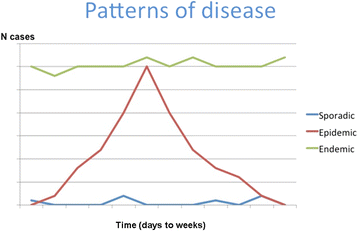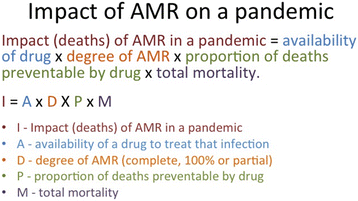Pandemics, public health emergencies and antimicrobial resistance - putting the threat in an epidemiologic and risk analysis context
- PMID: 28924475
- PMCID: PMC5597990
- DOI: 10.1186/s13690-017-0223-7
Pandemics, public health emergencies and antimicrobial resistance - putting the threat in an epidemiologic and risk analysis context
Abstract
Public health messaging about antimicrobial resistance (AMR) sometimes conveys the problem as an epidemic. We outline why AMR is a serious endemic problem manifested in hospital and community-acquired infections. AMR is not an epidemic condition, but may complicate epidemics, which are characterised by sudden societal impact due to rapid rise in cases over a short timescale. Influenza, which causes direct viral effects, or secondary bacterial complications is the most likely cause of an epidemic or pandemic where AMR may be a problem. We discuss other possible causes of a pandemic with AMR, and present a risk assessment formula to estimate the impact of AMR during a pandemic. Finally, we flag the potential impact of genetic engineering of pathogens on global risk and how this could radically change the epidemiology of AMR as we know it. Understanding the epidemiology of AMR is key to successfully addressing the problem. AMR is an endemic condition but can play a role in epidemics or pandemics, and we present a risk analysis method for assessing the impact of AMR in a pandemic.
Keywords: AMR; Antimicrobial resistance; Bacterial infections; Disease burden; Genetic engineered pathogens; Influenza; Pandemic; Public health; Risk; Superbug.
Conflict of interest statement
Authors’ information
Professor MacIntyre is a Professor of Infectious Diseases epidemiology and Head of the School of Public Health and Community Medicine, UNSW Medicine. She is also an adjunct professor at Arizona State University. She runs a highly strategic research program spanning epidemiology, vaccinology, mathematical modelling, PPE and clinical trials in infectious diseases. Chau Bui is doing a PhD on Avian Influenza epidemiology and has completed a Bachelor of Veterinary Science from USYD (2012) and a Masters of International Public Health from UNSW (2015).
Ethics approval and consent to participate
Not applicable.
Consent for publication
Not applicable.
Competing interests
The paper arose from a commissioned piece of work by AIA life insurance.
Publisher’s Note
Springer Nature remains neutral with regard to jurisdictional claims in published maps and institutional affiliations.
Figures
Similar articles
-
Risk modelling the mortality impact of antimicrobial resistance in secondary pneumococcal pneumonia infections during the 2009 influenza pandemic.Int J Infect Dis. 2019 Aug;85:1-6. doi: 10.1016/j.ijid.2019.05.005. Epub 2019 May 13. Int J Infect Dis. 2019. PMID: 31096052
-
Antimicrobial Resistance, the COVID-19 Pandemic, and Lessons for the Orthopaedic Community.J Bone Joint Surg Am. 2021 Jan 6;103(1):4-9. doi: 10.2106/JBJS.20.01214. J Bone Joint Surg Am. 2021. PMID: 33259429
-
Population-level mathematical modeling of antimicrobial resistance: a systematic review.BMC Med. 2019 Apr 24;17(1):81. doi: 10.1186/s12916-019-1314-9. BMC Med. 2019. PMID: 31014341 Free PMC article.
-
Global geographic trends in antimicrobial resistance: the role of international travel.J Travel Med. 2019 Dec 23;26(8):taz036. doi: 10.1093/jtm/taz036. J Travel Med. 2019. PMID: 31115466 Review.
-
Antimicrobial resistance, infection control and planning for pandemics: the importance of knowledge transfer in healthcare resilience and emergency planning.J Bus Contin Emer Plan. 2012 Autumn-2013 Winter;6(2):122-35. J Bus Contin Emer Plan. 2012. PMID: 23315247
Cited by
-
Medicinal plants used for the management of respiratory diseases in Zimbabwe: Review and perspectives potential management of COVID-19.Phys Chem Earth (2002). 2022 Dec;128:103232. doi: 10.1016/j.pce.2022.103232. Epub 2022 Sep 21. Phys Chem Earth (2002). 2022. PMID: 36161239 Free PMC article.
-
Atomic Force Microscopy (AFM) As a Surface Mapping Tool in Microorganisms Resistant Toward Antimicrobials: A Mini-Review.Front Pharmacol. 2020 Oct 2;11:517165. doi: 10.3389/fphar.2020.517165. eCollection 2020. Front Pharmacol. 2020. PMID: 33123004 Free PMC article. Review.
-
A Global Pandemic Treaty Must Address Antimicrobial Resistance.J Law Med Ethics. 2021;49(4):688-691. doi: 10.1017/jme.2021.94. J Law Med Ethics. 2021. PMID: 35006051 Free PMC article.
-
Converging and emerging threats to health security.Environ Syst Decis. 2018;38(2):198-207. doi: 10.1007/s10669-017-9667-0. Epub 2017 Nov 27. Environ Syst Decis. 2018. PMID: 32288980 Free PMC article. Review.
-
Antibiotic Use in Suspected and Confirmed COVID-19 Patients Admitted to Health Facilities in Sierra Leone in 2020-2021: Practice Does Not Follow Policy.Int J Environ Res Public Health. 2022 Mar 28;19(7):4005. doi: 10.3390/ijerph19074005. Int J Environ Res Public Health. 2022. PMID: 35409687 Free PMC article.
References
-
- World Health Organization. Blueprint for R&D preparedness and response to public health emergencies due to highly infectious pathogens - Workshop on prioritization of pathogens (8–9 December 2015). http://www.who.int/medicines/ebola-treatment/WHO-list-of-top-emerging-di.... Accessed 29 Nov 2016.
-
- Chrichton D. The Risk Triangle. In: Natural Disaster Management. edn. Edited by Ingleton J. Tudor Rose, London; 1999.
LinkOut - more resources
Full Text Sources
Other Literature Sources



